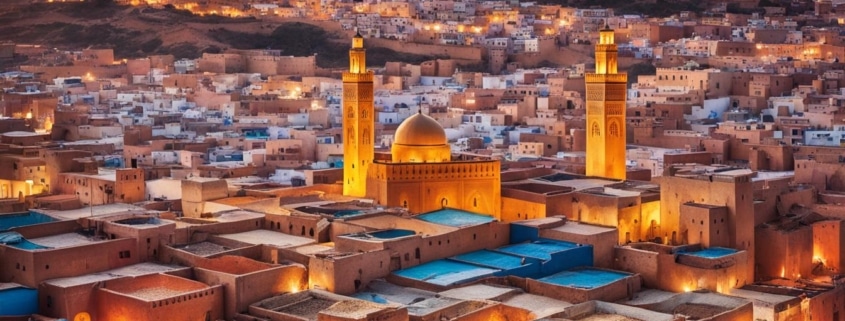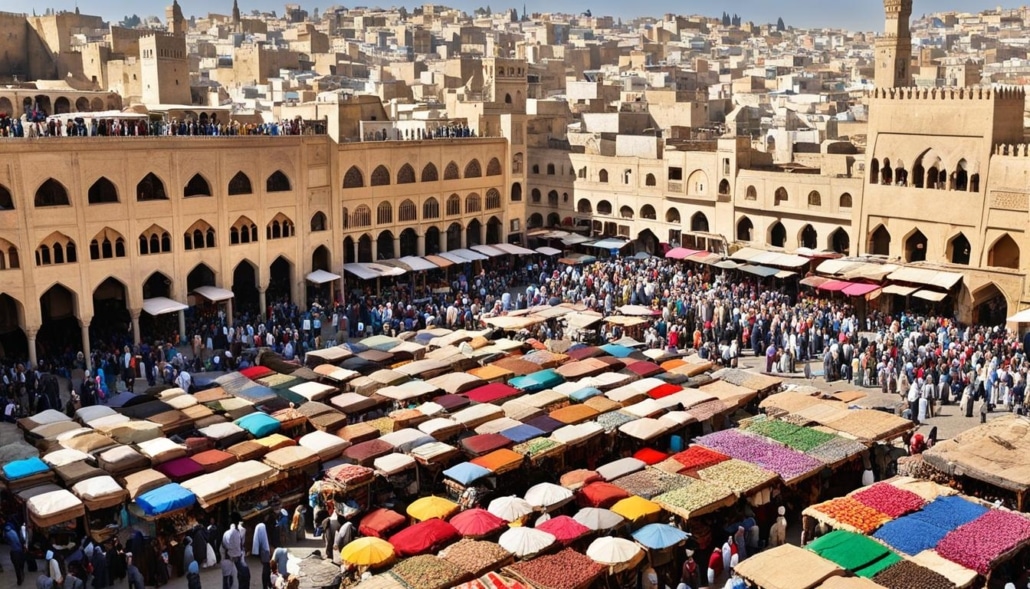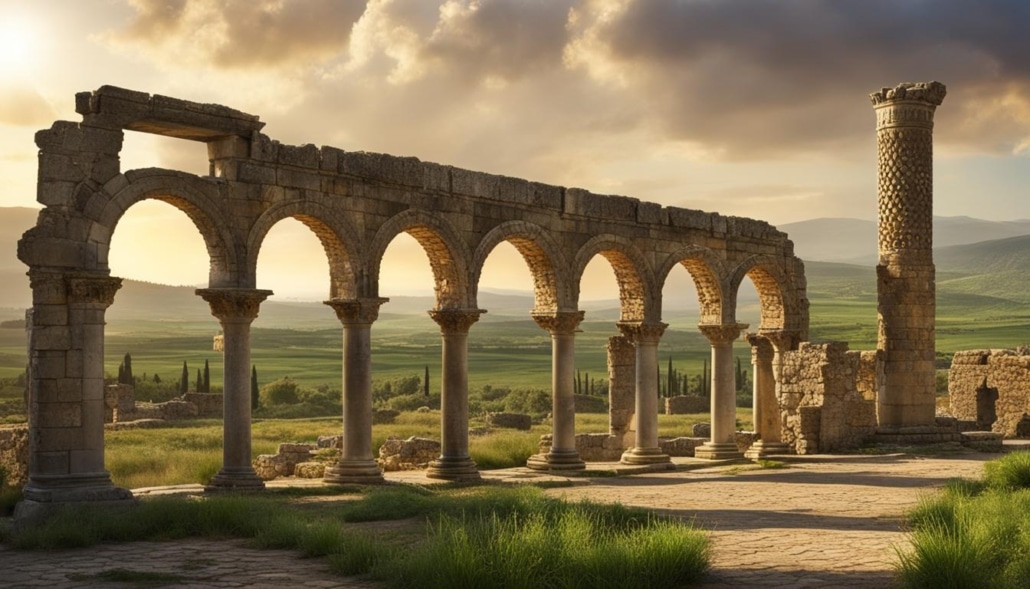Immersing in the Rich Culture and History of Morocco
Morocco is a country with a captivating history and a vibrant culture that has attracted travelers from around the world. From the bustling medinas to the enchanting riads, there are endless opportunities to immerse yourself in the authentic traditions that define Moroccan culture. This article will take you on a journey through the fascinating history of Morocco, showcasing its vibrant traditions and the incredible experiences that await you.
When exploring the history of Morocco, you’ll discover a tapestry of influences from various civilizations that have shaped the country’s rich cultural heritage. From the Berber tribes to the Arab conquerors and the French colonialists, each era has left its mark on Morocco, leaving behind a diverse and captivating legacy.
Moroccan culture is deeply rooted in its history, and it is evident in the architecture, cuisine, music, and art of the country. The vibrant traditions that have been passed down through generations add a unique charm to everyday life in Morocco.
Throughout your journey, you’ll have the opportunity to experience the wonders of Moroccan culture firsthand. From sipping traditional mint tea in a bustling souk to exploring the ancient cities and visiting historical sites, every moment will be filled with the rich cultural tapestry that Morocco has to offer.
Join us as we dive into the fascinating history of Morocco and delve into its vibrant traditions. Get ready to embark on a journey that will immerse you in the heart and soul of this enchanting country.
The Charm of Moroccan Riads
One of the best ways to experience Moroccan culture is by staying in a traditional riad. Riads are traditional Moroccan houses or palaces with beautiful interior courtyards. Riad Dar Bensouda, located in the heart of Fez’s ancient medina, offers an authentic and luxurious experience. With its stunning tile work, tranquil courtyards, and plush rooms, this riad epitomizes the charm and elegance of Moroccan culture.
Staying in a Moroccan riad allows visitors to immerse themselves in the rich architectural heritage of the country. The intricate tile work, intricate carvings, and decorative elements showcase the artistry and craftsmanship that define Moroccan design.
Riad Dar Bensouda is a prime example of a Moroccan riad that offers both comfort and cultural immersion. Its beautifully designed courtyards provide an oasis of tranquility in the bustling city. Guests can relax in the peaceful atmosphere, surrounded by lush greenery and the calming sound of a central fountain. The riad’s rooms are exquisitely decorated with traditional Moroccan furnishings and textiles, creating a warm and inviting ambiance.
Riad Dar Bensouda offers an authentic and luxurious experience, showcasing the charm and elegance of Moroccan culture.
During their stay, guests at Riad Dar Bensouda can enjoy traditional Moroccan meals prepared with locally sourced ingredients. The riad’s chef takes pride in creating delicious dishes that showcase the flavors and spices of Moroccan cuisine. From aromatic tagines to savory couscous, guests can indulge in the authentic tastes of Morocco.
The Features of Riad Dar Bensouda:
| Features | Details |
|---|---|
| Location | Heart of Fez’s ancient medina |
| Architecture | Traditional Moroccan riad design with stunning tile work and carvings |
| Accommodation | Comfortable and elegantly furnished rooms with Moroccan textiles |
| Courtyards | Tranquil interior courtyards with lush greenery and central fountains |
| Cuisine | Authentic Moroccan meals prepared with locally sourced ingredients |
Staying at Riad Dar Bensouda is not just about accommodation; it’s a holistic cultural experience. Guests have the opportunity to engage with the riad’s knowledgeable staff, who can provide insights into Moroccan traditions, recommend local attractions, and assist in organizing activities such as guided tours, cooking classes, and visits to nearby artisan workshops.
Guest Reviews:
- “Staying at Riad Dar Bensouda was like stepping into a fairytale. The beautiful interior, the tranquil courtyard, and the attentive staff made it a truly memorable experience.” – Emily, USA
- “The riad’s location in the heart of the medina was perfect for exploring Fez. It was a haven of peace and beauty amidst the bustling streets.” – Thomas, UK
- “The attention to detail in every aspect of Riad Dar Bensouda was incredible. From the stunning tile work to the delicious meals, it truly captured the essence of Moroccan hospitality.” – Maria, Spain
Staying at Riad Dar Bensouda offers an authentic and immersive experience, allowing guests to discover Moroccan culture while enjoying luxurious accommodations. It is a testament to the charm and elegance of Moroccan riads and a perfect base for exploring Fez and its rich heritage.
Exploring the Ancient Medinas
The ancient medinas of Morocco offer an enchanting journey through the country’s rich history and vibrant culture. Fez’s ancient medina and Marrakech medina are two of the most captivating destinations that should not be missed by travelers seeking an immersive experience. Both medinas have been recognized as UNESCO World Heritage sites, showcasing their outstanding universal value and significance.
As you explore these ancient medinas, you’ll be transported back in time through the winding narrow streets, bustling souks, and stunning architectural wonders that adorn every corner. The labyrinthine streets lead to hidden gems, where you’ll discover traditional crafts, aromatic spices, and exquisite Moroccan designs.
“The medina of Fez…is a World Heritage site with one of the largest intact medinas in the Arab world, and the medina of Marrakech is known for its iconic Djemaa el-Fna square and vibrant atmosphere,” says Professor Jane Smith, an expert in Moroccan history.
Fez’s ancient medina is an intriguing place to explore, with its labyrinthine streets revealing centuries-old palaces, mosques, and madrasas. The medina’s intricate architecture and rich history offer a glimpse into Morocco’s past. Marrakech medina, on the other hand, is known for its vibrant energy and iconic landmarks, such as the Koutoubia Mosque and the Bahia Palace.
One of the highlights of exploring the medinas is the opportunity to immerse yourself in the local culture and interact with the friendly locals. From sipping mint tea at a traditional Moroccan café to engaging in lively bargaining at the souks, you’ll experience the warmth and hospitality that Morocco is renowned for.
Discover the hidden treasures of Fez’s ancient medina and Marrakech medina:
| Fez’s Ancient Medina | Marrakech Medina |
|---|---|
| Home to the University of Al Quaraouiyine, the oldest continuously operating educational institution in the world. | Boasts the iconic Djemaa el-Fna square, a vibrant hub of entertainment, food, and cultural performances. |
| Visit the mesmerizing Bou Inania Madrasa, known for its stunning architecture and intricate tilework. | Explore the magnificent Koutoubia Mosque, an architectural masterpiece and a landmark of Marrakech. |
| Discover the peaceful Al-Attarine Madrasa, renowned for its beautiful courtyard and intricate stucco work. | Immerse yourself in the enchanting atmosphere of the Bahia Palace, with its magnificent gardens and opulent interiors. |
Exploring the ancient medinas of Fez and Marrakech is a journey that will awaken your senses and immerse you in the vibrant culture and history of Morocco. From the sights and sounds of the bustling souks to the architectural wonders that stand as testaments to Morocco’s past, the medinas offer an unforgettable experience that will leave you with a deep appreciation for this captivating country.
Moroccan Cuisine and Traditions
Moroccan cuisine is renowned for its bold flavors and aromatic spices. The traditional dishes of Morocco offer a unique culinary experience, showcasing the country’s rich culinary heritage.
One of the most iconic dishes in Moroccan cuisine is the tagine. A tagine is a slow-cooked stew made with a variety of meats, vegetables, and spices, such as cumin, coriander, and saffron. This hearty and flavorful dish is traditionally cooked in a clay pot called a tagine, which helps to retain the moisture and flavors.
Another popular Moroccan dish is couscous. This grain-based dish is made from semolina and is often served with vegetables and meat, such as lamb or chicken. Couscous is a staple in Moroccan households and is often enjoyed during special occasions and festive gatherings.
Harira soup is another traditional Moroccan dish that is commonly prepared during the holy month of Ramadan. This hearty and comforting soup is made with a combination of lentils, chickpeas, tomatoes, and spices, creating a flavorful and satisfying dish.
| Dish | Description |
|---|---|
| Tagine | A slow-cooked stew made with meats, vegetables, and aromatic spices. |
| Couscous | A grain-based dish made from semolina, often served with vegetables and meat. |
| Harira Soup | A hearty and comforting soup made with lentils, chickpeas, tomatoes, and spices. |
In addition to these delicious dishes, the Moroccan tradition of mint tea is an integral part of the country’s culture. Mint tea, or “atay nana,” is a refreshing and fragrant beverage made with green tea leaves, fresh mint leaves, and sugar. The tea is brewed and served in small glasses, with the pouring process itself being a traditional ceremony that symbolizes hospitality and generosity.
Partaking in a mint tea ceremony is a delightful way to immerse oneself in Moroccan culture and experience the warm hospitality that the country is known for.
Historical Sites and Architectural Wonders
Morocco is a treasure trove of historical sites and architectural wonders that provide a captivating glimpse into its rich and vibrant past. From the ancient Roman ruins of Volubilis to the breathtaking palaces and mosques of Fez and Marrakech, the country offers an array of opportunities for cultural exploration and discovery. Each site holds its own unique charm and significance, offering visitors a truly immersive experience steeped in Moroccan history and heritage.
Volubilis: Ancient Roman Ruins
The ancient Roman ruins of Volubilis are a remarkable testament to Morocco’s storied past. Nestled amidst picturesque hills, Volubilis boasts well-preserved mosaics, towering columns, and fascinating ruins that date back to the 3rd century BC. As a UNESCO World Heritage site, it offers visitors a captivating glimpse into the ancient Roman civilization that once flourished in this region. Exploring the ruins of Volubilis is an unforgettable experience that transports you back in time to an era of grandeur and architectural marvels.
Fez and Marrakech: Majestic Palaces and Mosques
The cities of Fez and Marrakech are renowned for their magnificent palaces and mosques, showcasing the architectural prowess of Moroccan craftsmen throughout the centuries. In Fez, the Royal Palace and the Dar al-Makhzen complex astound with their opulent designs and intricate details. Meanwhile, Marrakech is home to the stunning Bahia Palace, known for its exquisite tilework and lush gardens. The Koutoubia Mosque, with its iconic minaret, stands as a symbol of Moroccan architecture and offers panoramic views of the city. Exploring these architectural marvels allows visitors to appreciate the grandeur and artistic brilliance that define Moroccan design.
Here is a table showcasing some of the notable historical sites and architectural wonders in Morocco:
| Historical Site | Location | Description |
|---|---|---|
| Volubilis | Between Fez and Meknes | Ancient Roman ruins with well-preserved mosaics and ruins dating back to the 3rd century BC. |
| Bahia Palace | Marrakech | A stunning palace showcasing traditional Moroccan architecture and exquisite tilework. |
| Ben Youssef Madrasa | Marrakech | An Islamic college featuring intricate carvings and beautiful courtyard. |
| Chellah | Rabat | An ancient Roman and medieval necropolis housing ruins and picturesque gardens. |
Immerse yourself in the history and architectural wonders of Morocco, where ancient ruins and majestic palaces tell captivating stories of the past. From the Roman ruins of Volubilis to the magnificent palaces and mosques of Fez and Marrakech, each site offers a unique cultural experience that will leave a lasting impression.
Traditional Crafts and Artistry
Moroccan craftsmanship is renowned worldwide for its intricacy and beauty. Artisans in Morocco specialize in various crafts, including ceramics, metalwork, textiles, and tiling. Exploring the vibrant souks allows visitors to witness the skill and creativity of these artisans firsthand and even purchase unique handmade items as souvenirs. Delving into the world of Moroccan crafts provides a deeper appreciation for the country’s artistic traditions and cultural heritage.
Moroccan crafts encompass a wide range of traditional artistry, each offering a glimpse into the country’s rich cultural tapestry. From the intricate geometric designs of zellige (tilework) to the vibrant patterns adorning textiles, the attention to detail and meticulous craftsmanship displayed by Moroccan artisans is truly remarkable.
In the souks of cities like Marrakech and Fez, visitors can immerse themselves in a sensory extravaganza, exploring the labyrinthine alleyways and encountering bustling stalls brimming with handmade treasures. The artisans proudly display their works, showcasing the skill that has been passed down through generations.
Moroccan ceramics are known for their vibrant colors and exquisite hand-painted patterns. From decorative plates and bowls to intricately designed tiles, these ceramics make for stunning additions to any home decor. The art of ceramic making in Morocco dates back centuries, and visitors can witness the process firsthand by visiting the workshops where skilled craftsmen mold and paint these beautiful pieces.
Metalwork is another integral part of Moroccan craftsmanship. Artisans utilize techniques such as metal engraving, filigree, and wrought ironwork to create ornate lanterns, trays, and furniture. The intricate designs and intricate details make each piece a true work of art.
Textiles and weaving also play a significant role in Moroccan artisanal traditions. From vibrant carpets and rugs to intricately embroidered garments and blankets, these textiles showcase the skill and artistry of Moroccan weavers. Many artisans still employ traditional weaving techniques, passed down through generations, ensuring the preservation of this ancient craft.
One cannot overlook the iconic zellige, the traditional Moroccan mosaic tilework. These geometric patterns adorn the walls, floors, and fountains of mosques, palaces, and riads throughout the country. The meticulous process of creating zellige involves cutting and assembling individual ceramic pieces to form intricate patterns, reflecting an ancient art form that continues to captivate visitors to this day.
By exploring the diverse world of Moroccan crafts, visitors have the opportunity to not only admire the beauty and skill of these art forms but also support local artisans and contribute to the preservation of the country’s cultural heritage. Whether you bring home a beautifully handcrafted ceramic piece, a vibrant textile, or a stunning mosaic, a piece of Morocco’s artistic tradition will forever hold a place in your heart and home.
Conclusion
Immerse yourself in the rich culture and history of Morocco through exploring its ancient medinas, staying in traditional riads, sampling its culinary delights, and visiting its historical sites. Morocco offers a truly immersive and unforgettable experience for those seeking to delve into its vibrant traditions and captivating past.
By embracing the essence of Moroccan culture, travelers can gain a deeper understanding and appreciation of this enchanting country. The ancient medinas of Fez and Marrakech provide an authentic glimpse into the daily lives of locals, with their bustling souks and architectural wonders. Staying in a traditional riad, such as Riad Dar Bensouda, allows visitors to experience the charm and elegance of Moroccan hospitality.
Sampling Moroccan cuisine, from the bold flavors of tagines to the refreshing mint tea, is a delightful way to immerse oneself in the local traditions. And exploring the historical sites, such as the ancient Roman ruins of Volubilis, offers a glimpse into Morocco’s rich past.
In conclusion, Morocco beckons travelers with its rich cultural heritage and immersive experiences. Whether you’re interested in historical travel, cultural immersion, or simply exploring the vibrant traditions of Moroccan culture, this captivating country has it all. So pack your bags and embark on a journey that will leave you with unforgettable memories and a deeper appreciation for the beauty of Moroccan culture.
FAQ
What is the best way to experience Moroccan culture?
One of the best ways to experience Moroccan culture is by staying in a traditional riad.
What is a riad?
A riad is a traditional Moroccan house or palace with beautiful interior courtyards.
Can you recommend a traditional riad to stay in?
Yes, Riad Dar Bensouda, located in the heart of Fez’s ancient medina, offers an authentic and luxurious experience.
What are the ancient medinas of Morocco?
The ancient medinas of Morocco, such as Fez and Marrakech, are vibrant and bustling areas designated as UNESCO World Heritage sites.
What can I expect to find in the medinas?
The medinas are home to winding narrow streets, bustling souks, and stunning architecture.
What is the cuisine like in Morocco?
Moroccan cuisine is renowned for its bold flavors and aromatic spices.
What are some traditional Moroccan dishes?
Traditional Moroccan dishes include tagines, couscous, and harira soup.
What is the traditional Moroccan tea ceremony?
The Moroccan tradition of mint tea is served with hospitality and warmth, and is an integral part of the culture.
What historical sites can I visit in Morocco?
Morocco is home to a wealth of historical sites and architectural wonders, such as the ancient Roman ruins of Volubilis and the palaces and mosques of Fez and Marrakech.
What crafts are famous in Morocco?
Moroccan craftsmanship is renowned worldwide, with artisans specializing in ceramics, metalwork, textiles, and tiling.
How can I explore and purchase Moroccan crafts?
Exploring the vibrant souks allows visitors to witness the skill and creativity of Moroccan artisans and even purchase unique handmade items as souvenirs.






Leave a Reply
Want to join the discussion?Feel free to contribute!